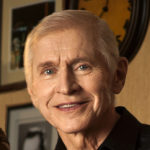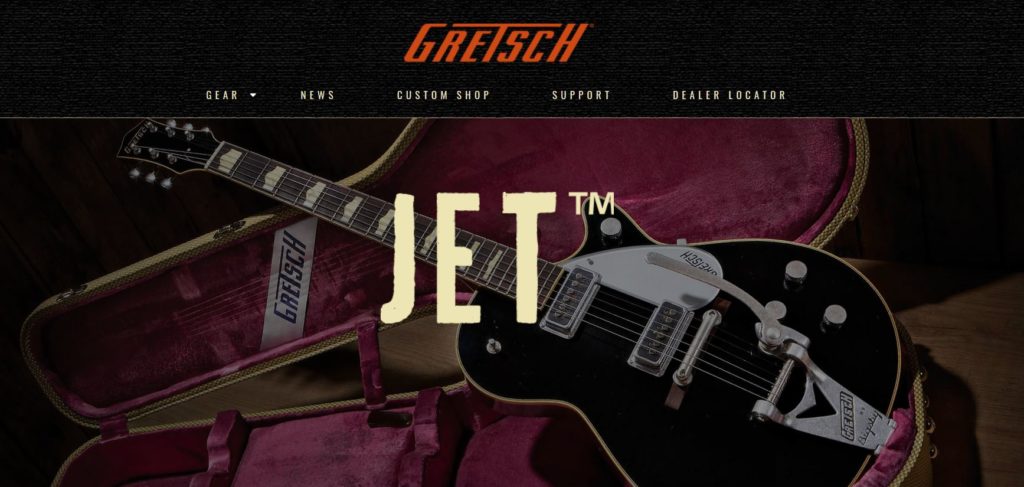The Gretsch Duo Jet: Still Rockin’ at 70
 In January 1951, Gretsch let the music world know it was a serious contender in the quickly evolving electric guitar business when it introduced the Electromatic and Electro II models at a three-day promotional show at New York’s Park Sheraton Hotel.
In January 1951, Gretsch let the music world know it was a serious contender in the quickly evolving electric guitar business when it introduced the Electromatic and Electro II models at a three-day promotional show at New York’s Park Sheraton Hotel.
Meanwhile, on the west coast in Fullerton, California, the Fender Company was manufacturing a groundbreaking concept: a solid body electric guitar with a bolt-on neck. A year later in 1952, my uncle and Gretsch president Fred Gretsch Jr., was more than surprised when rival Gibson introduced the Les Paul “Gold Top” solid body electric guitar.
Seeing the sales success of these new, untraditional guitars, my uncle realized solid body guitars were more than a passing fad. He assembled his guitar brain trust of Jimmie Webster, Duke Kramer, and Phil Grant and the team worked diligently to develop the Gretsch Duo Jet, one of the most desired guitars of the 1950s that’s still going strong 70 years later.
Introduced in 1953, the Duo Jet had a cool name (“Duo” for its two Dynasonic pickups and “Jet” which reflected the most advanced aircraft technology of the day) to go along with its cool, elegant looks and great sound.
The single-cutaway Duo Jet featured a gleaming black arched top — some made from Nitron plastic drum material — with mahogany sides, back and neck. Other Gretsch firsts included truss rod adjustments through the headstock (concealed with a bullet-shaped cover), a master volume control knob on the cutaway, and a pickup selection switch. With two DeArmond Dynasonic pickups, a Melita Synchro-Sonic bridge, chrome hardware, white and black binding, and hump block inlays, the Duo Jet’s upscale black and chrome look was simply stunning.
It also lived up to its “Great Gretsch Sound” reputation thanks to the Duo Jet’s unique construction. Although it looked like a solid body, the inside was actually chambered to allow for wiring and components and to make the Duo Jet lighter and more comfortable to play. This “semi-solid” approach also gave the Duo Jet a unique sound that ranged from jangly and twangy to smooth and mellow. A perfect guitar for playing country and western, pop, and jazz music in 1953, as well as rock ‘n’ roll which was about to explode onto the music scene.
Some of the most influential guitarists who played early Duo Jets were Hank Garland, rockabilly great Cliff Gallup of Gene Vincent and His Blue Caps, and the Beatles’ George Harrison. George’s ’57 Duo Jet was his sentimental favorite and he described it as his first “good guitar” when he bought it used in 1960. It’s unique tone shaped the sound and energy of the Beatles’ early recordings. We honored George’s famous ’57 Duo Jet in 2011 with a limited edition Custom Shop Tribute Duo Jet.
The popularity of the Duo Jet continues to ascend to new heights. From legends like Jeff Beck and David Gilmour, to some of today’s hottest players like Nick 13 and Alex Trimble, there’s no slowing down the Duo Jet Express. In fact, we offer more than 20 models including the George Harrison and Malcolm Young Signature models, Jet Firebirds, Silver Jets, and Sparkle Jets.
In retrospect, it’s been 70 years since my uncle and his talented team wrote an important chapter in the Gretsch Company’s guitar history book: creating and marketing a successful solid body electric guitar. One only has to look at the longevity and success of the Duo Jet — which has changed very little over 70 years — to know they found the right recipe within the walls of the Gretsch factory at 60 Broadway in Brooklyn way back in 1953.
— Fred W. Gretsch
(4th Generation Gretsch Company President)

.
See all the current Gretsch Jet models at Gretschguitars.com.




 Previous
Previous